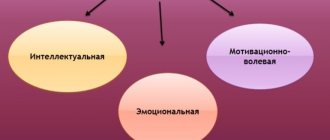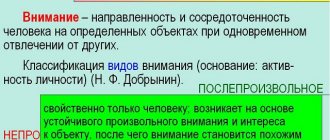Sustainability of attention
Stability lies in the ability to focus on one object for a certain time, so it is a temporary characteristic of attention. This property of attention can be determined by peripheral and central factors.
Research has shown that attention is subject to periodic involuntary fluctuations. According to N.N. Lange, periods of such oscillations are usually 2-3 seconds and reach a maximum of 12 seconds. If you try to concentrate on the ticking of a clock, you will sometimes hear it, sometimes not. Oscillations when observing more complex figures are of a different nature. In them, first one and then the other part will alternately appear as a figure. For example, an image of a truncated pyramid will give this effect. A truncated pyramid is shown in the figure:
Are you an expert in this subject area? We invite you to become the author of the Directory Working Conditions
If you look at the pyramid for some time, it will alternately appear convex and concave. Small periods of fluctuations in attention are not a general pattern. The most essential condition for sustained attention is the ability to reveal new aspects and connections in a subject.
When attention is unstable under all conditions, more or less effective mental work would be impossible. The stability of attention also depends on other conditions - the degree of complexity of the material and the difficulty of getting to know it, the understandability of the material, the subject’s attitude towards it, the individual characteristics of the individual.
The stability of attention can be checked using the Bourdon table. It consists of a random alternation of individual letters. In each line, each letter is repeated the same number of times. The subject must cross out given letters for a long time. The stability of attention is similarly tested using Kraepelin tables. They consist of columns of numbers, and the subject must add them for a long time. The number of errors made and work productivity are indicators of fluctuations in attention.
Finished works on a similar topic
Course work Characteristics of the properties of attention 400 ₽ Abstract Characteristics of the properties of attention 230 ₽ Test paper Characteristics of the properties of attention 240 ₽
Receive completed work or specialist advice on your educational project Find out the cost
2.1. Research methodology
When theoretically considering the characteristics of attention, it was clear that in children of primary school age involuntary attention is developed much better than voluntary attention. We need to confirm this assumption empirically. The study was conducted in one of the Moscow schools. The subjects were 10 2nd grade students, including 6 girls and 4 boys. The age of the subjects is 7-8 years. The class is friendly, the children are sociable. The children took an active part in the experiment and tried hard. To study the level of development of attention of younger schoolchildren, the following methods were used:
- determination of productivity and stability of attention (modification of the Pieron-Ruzer method),
- Bourdon's proof test,
- “Schulte Table” technique for determining the amount of attention.
1.Pieron-Ruzer technique
Goal: Determining the level of distribution, switching and stability of attention.
Material: form with drawings of figures, pencil (pen).
Instructions: “Encode the table by arranging the signs in it according to the pattern.”
Research procedure: the subject is offered a form on which various figures are drawn. At the top of the form is a sample: in each of the presented figures (one of each type) an icon is drawn: a dash, an = sign, a circle, vertical dashes and an = sign. The subject is asked to arrange the icons placed in the sample figures into the figures corresponding to the sample. The task is completed for a while.
Processing the results: The number of errors and the time spent on completing the task are recorded.
High level – 100% in 1 minute 15 seconds without errors. Average level - 60% in 1 minute 45 seconds with 2 errors. Low level – 50% in 1 min 50 sec with 5 errors. Very low level - 20% in 2 minutes 10 seconds with 6 errors.
2. Bourdon’s “Corrective Test” Test
Goal: determining the level of concentration of attention, its switching and distribution, absorption into activities and fatigue.
Equipment: Table with test objects, geometric figures (signs), stopwatch, pencil or pen.
Description of the technique: The task is given at the beginning of the day. The experimenter notes on the sheet the number of characters viewed. Record the task completion time – 4 minutes.
Instructions: Cross out the circles with one line from top to bottom, and the squares with two lines in each line. Work quickly and carefully, try not to miss anything. Once you complete one line, move on to the second and so on until you complete the task on the entire sheet.
3. Methodology “Schulte Tables”
Purpose: to study the speed of orienting-search movements of the gaze, the volume of attention.
Equipment: stopwatch, 4 tables, with numbers from 1 to 25, arranged in a chaotic order.
Description of the method: The child is presented with a table, and at the “start” signal, the researcher starts the stopwatch. The time spent working with each table is recorded.
Instructions: Point with a pointer and name all the numbers from 1 to 25. As quickly as possible, without making mistakes.
Processing of results: The norm for this age is 30 – 50 seconds spent on each table. The average rate is 40-42 seconds. Normally, each table takes approximately the same time.
Concentration of attention
Definition
Concentration is the next property of attention, which implies the intensity of concentration.
Concentration of attention, believed A.A. Ukhtomsky, is associated with the peculiarities of the functioning of the dominant focus of excitation in the cortex. In his opinion, this is a consequence of excitation in the dominant focus with simultaneous inhibition of other areas of the cerebral cortex.
Since attention can be voluntary and involuntary, then, accordingly, concentration of attention is produced both by an effort of will and by itself, based on personal interest. Maintaining attention for a long time in the first case requires a large amount of energy, which can lead to exhaustion. Concentration will be less tiring if it is based on interest in the object and leads to greater productivity. Naturally, engaging in activities that arouse genuine interest is very important for a person.
The ability to focus on a specific object develops with age. It is difficult for kids to concentrate for a long time, but younger schoolchildren can sit through lessons without any problems. Thus, they acquire the ability to learn. By concentrating on one subject for a long time, the child gradually gets used to the loads and copes with them more easily, and by the end of school he is already fluent in voluntary attention.
There are many exercises to develop concentration, for example, brain impulses, the center of the universe, counting, etc.
Psychological properties
Attention is a type of mental activity that reflects a specific object and whose task is to protect the brain from unnecessary information by selecting only useful and relevant information. Concentration is a fortunate acquisition during human evolution. Its interpretation to this day among psychologists is ambiguous, and the lack of unity of opinions forms the essence of the process itself.
Attention and its psychological properties have been studied in detail in medical practice, and recommendations have been developed for correcting deviations in these properties. This phenomenon refers to an end-to-end process that accompanies other types of activity: memory, emotions, thinking. At the same time, characteristic features are identified that indicate a high level of independence of this mental state.
Distribution of attention
Definition
Distribution of attention is a person’s ability to simultaneously perform several types of activities.
Of course, the classic example of such ability is Julius Caesar. Tradition says that he could do seven unrelated things at the same time. It is also known that Napoleon could simultaneously dictate seven important diplomatic documents to his secretaries.
Practice, however, shows that a person can perform only one type of conscious mental activity. The subjective feeling of doing several things at the same time arises because a person quickly and consistently switches from one type of activity to another. As W. Wundt proved, a person cannot simultaneously concentrate on two presented stimuli. However, sometimes a person is actually able to perform two types of activities, but, in this case, one of the types should be completely automated and not require attention. If this condition is not met, combining activities is impossible. The distribution of attention, as a number of authors believe, is the reverse side of another property - switchability.
Switching attention
Definition
Switching is understood as a conscious and meaningful movement of attention from one object to another.
In general, this means the ability to quickly navigate a complex, changing situation.
The ease of switching varies from person to person and depends on a number of conditions. First of all, this is the relationship between previous and subsequent activities, as well as the subject’s attitude towards each of them.
It is much easier to switch to an interesting activity and vice versa. Switching attention is well trained.
Attention span
Volume is another property of attention and represents the number of objects that a person can cover simultaneously with sufficient clarity.
As we know, a person cannot think about different things and perform different tasks at the same time. Such a limitation forces information coming from outside to be split into parts without exceeding the capabilities of the processing system.
During learning and training, the volume of attention practically does not change, and its indicator is the number of clearly perceived objects. Different people have different attention spans. This depends on the extent to which the content on which attention is focused is interconnected, as well as on the ability to meaningfully connect and structure the material. The scope of attention is very close to the concept of the scope of perception.
BIBLIOGRAPHY
- Anufriev A.F., Kostromina S.N. How to overcome difficulties in teaching children. Psychodiagnostic tables. Psychodiagnostic techniques. Corrective exercises. – 4th ed., erased. – M.: Publishing house “Os-89”, 2006. – 272 p. (Practical psychology)
- Large psychological dictionary / Comp. and general ed. B. Meshcheryakov, V. Zinchenko, - St. Petersburg: prime, - EUROZNAK, 2003. - 672 p. (Project “Psychological Encyclopedia”)
- Age-related characteristics of the mental development of children. \ Ed. M. I. Lisina. – M.: Nauka, 1982. – 306 p.
- Age characteristics of students and their consideration in the organization of the educational process. \ Ed. V.V. Davydov, D. I. Feldshtein, D. B. Elkonin. - M., 1975.
- Galperin P.Ya. On the problem of attention / Reader on psychology / Ed. A.V. Petrovsky. – M.: Education, 1987. – 447 p.
- Zabramnaya S.D., Borovik O.V. From diagnosis to development: A manual for the psychological and pedagogical study of children in preschool institutions and primary schools. Ed. – 2nd, revised and expanded. – M.: Sekachev, – 2004.
- Zabrodin Yu.M., Nosulenko V.N. Psychological study of cognitive processes and personality. – M, 1981. – 199 p.
- Craig G. Developmental Psychology. – St. Petersburg: Peter, 2002.
- Kulagina I.Yu., Kolyutsky V.P. Developmental psychology: The complete life cycle of human development. Textbook for students of higher educational institutions. – M.: Sphere shopping center, 2001. – 464 p.
- Kuzma L.P. Types of violations of voluntary attention in primary school students: Dis. ...cand. psychol. Sciences: 19.00.07: Yaroslavl, 2005. – 149 p.
- Leites N.S. Mental abilities and age. – M.: Education, 1991. – 306 p.
- Lishin O.V. Pedagogical psychology of education. – M., 2005. – 487 p.
- Lokalova N.P. How to help a low-performing student. Psychodiagnostic tables: causes and correction of difficulties in teaching primary schoolchildren the Russian language, reading and mathematics. – 3rd ed., revised. and additional – M.: “Os-89”, 2005. – 96 p.
- Lokhov M.I., Fesenko Yu.A., Rubin M.Yu. Bad good child. (Developmental problems, behavioral disorders, attention, writing and speech disorders). St. Petersburg, 2003. – 320 p.
- Luria A. R. Attention and memory. – M.: Nauka, 1975. – 302 p.
- Mash. E., Wolf D. Children's pathopsychology. Child mental disorders. – SPb.: Prime-EVROZNAK, 2002. – 384 p.
- General psychology / Ed. A.V.Petrovsky. M.: Nauka, 1986. – 426 p.
- Piaget J. Selected psychological works. M.: Progress, 1994. – 230 p.
- Workshop on developmental psychology / Ed. L.A. Golovey, E.F. Rybalko. – St. Petersburg: Rech, 2001. – 514 p.
- Workshop on general, experimental and applied psychology: Proc. allowance / Ed. A.A. Krylova, S.A. Manicheva. – St. Petersburg: Peter, 2001. – 560 p.
- Implementation of your own startup in the field
- Children's and youth sports school as a management object, using the example of educational management
- Factors influencing the effectiveness of management decisions in an innovation project
- Justification of the enterprise's target market
- Personality education in the process of physical education and sports.
- Development of an enterprise strategy using the example of FinSovetnik LLC
- Commercial activities of a retail trade enterprise and its improvement (using the example of a specific organization)
- SWOT analysis and proposal for a marketing strategy for promoting the M&M's brand (Mars concern) for 2022
- Development of a strategic marketing plan for BC Soratnik
- Empirical studies of the properties of attention (PSYCHOLOGICAL FEATURES OF ATTENTION PROPERTIES)
- Color rendition and essence of Claude Monet's painting "Lady in the Garden"
- Features of commercial activities in the field of wholesale trade











